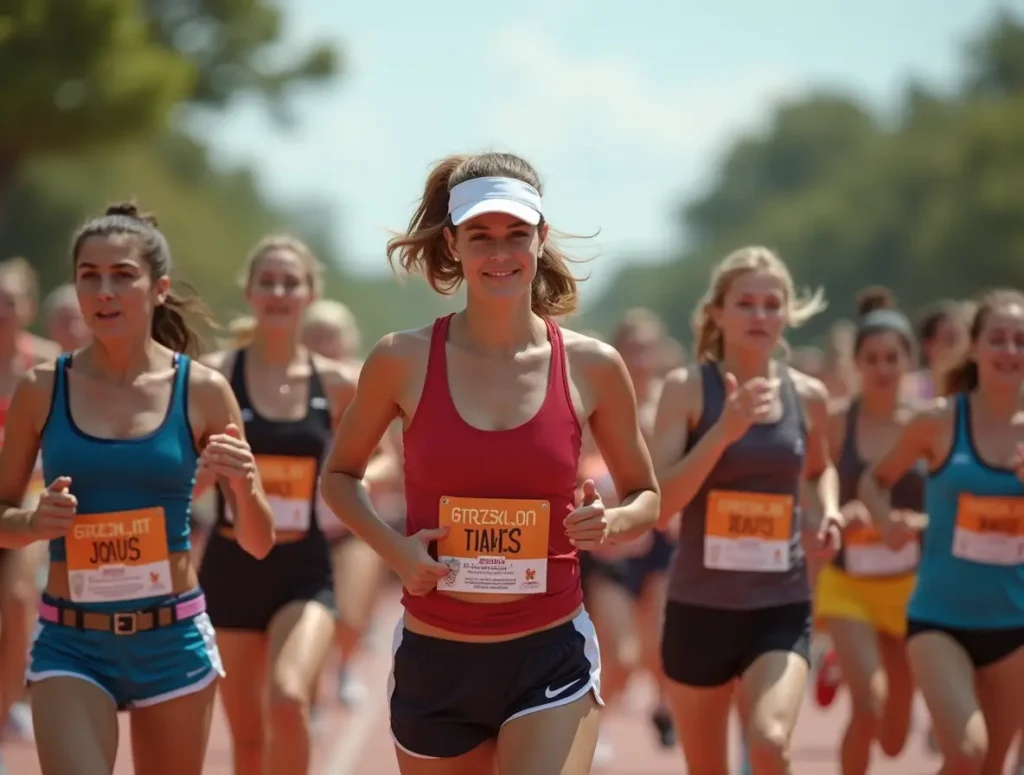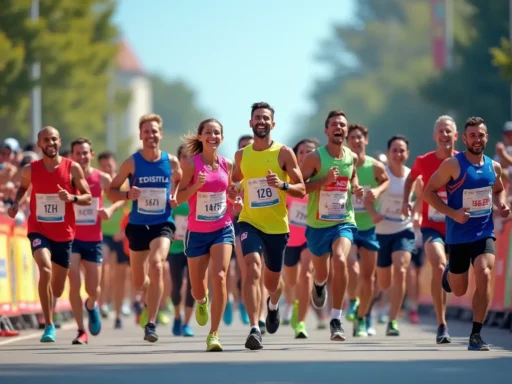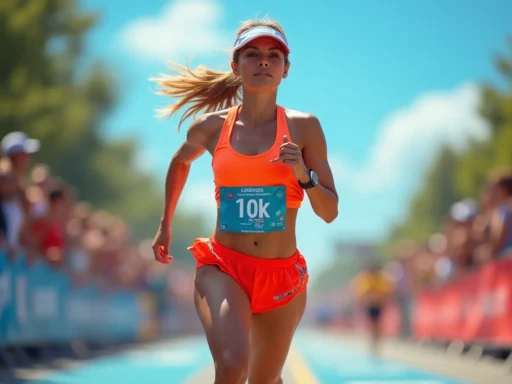Starting your 10k race journey? First, you might wonder how many miles in a 10k. A 10k race is 6.2 miles long, which is twice a 5k’s 3.1 miles. Knowing this distance is key to your training and setting goals.

Knowing the 10k distance helps you plan your training. You might ask how long it takes to finish. Men usually finish in 55:37, while women take about 1:03:17. But, with a good training plan, you can get faster and finish the race.
As a beginner, building endurance is crucial. Understanding the 10k distance keeps you motivated. So, let’s begin your 10k journey and learn how to succeed.
Table of Contents
Understanding How Many Miles in a 10k
Getting ready for a 10k race means knowing the distance. A 10k race is 6.2 miles long. This info is key for your training plan, including how hard and often you’ll run.
A 5k race is about half that, at 3.1 miles. So, a 10k is tougher but more fulfilling. Beginners might run a mile in 9 to 14 minutes. This helps you guess your finish time and set goals.
Introduction to the Distance
Knowing the 10k distance is crucial for a good training plan. With 6.2 miles, you can build endurance and speed. Include long runs, intervals, and rest days to recover.
For instance, running at 10 minutes per mile, you’ll finish a 10k in about 62 minutes. This helps you plan and set goals. With proper training, you can finish the race with confidence.
The History and Significance of the 10k Distance
The 10k distance, or 6.2 miles, has a rich history in the running world. It serves as a stepping stone for longer races. This makes it a favorite among runners of all levels.
Origins of the 10k Race
The 10k’s roots are in traditional road racing. The first recorded 10k event was in 1897. The Běchovice–Prague race, one of the longest-running, has been held every year since then.
Why 10k is a Popular Racing Distance
The 10k distance is easy to access, making it very popular. Many local governments partner with races to encourage fitness. Events like the Peachtree Road Race and the Vancouver Sun Run draw thousands each year.
Notable 10k Events Worldwide
Some notable 10k events include:
- Peachtree Road Race: Over 55,000 participants in 2011
- Vancouver Sun Run: Close to 50,000 runners in recent years
- Bolder Boulder: Nearly 50,000 participants annually
These events show the 10k’s global appeal and importance in the running world.
Converting Kilometers to Miles for Your 10k Journey
Getting ready for your 10k race means knowing the distance in miles. To convert 10k to miles, remember that 1 kilometer is about 0.62 miles. So, for a 10k race, you multiply 10 kilometers by 0.62. This equals about 6.2 miles.
Here’s a simple guide to convert 10k to miles:
- Start with the distance in kilometers (10k)
- Multiply the distance by the conversion factor (0.62)
- Calculate the result (10 x 0.62 = 6.2 miles)
You can also use online tools or apps, like ConvertUnits.com or OnlineConversion.com, to convert 10k to miles. Many GPS running watches also let you show distance in both kilometers and miles.
Knowing the distance in miles helps you prepare for your 10k race. By using the formula or online tools, you can easily convert 10k to miles and focus on your training.
Converting kilometers to miles is easy. With practice, you’ll get used to it. It will help you as you keep training for your 10k journey.
| Kilometers | Miles |
|---|---|
| 10k | 6.2 miles |
| 5k | 3.1 miles |
| 1k | 0.62 miles |
Essential Gear for 10k Training and Racing
When training for a 10k marathon, having the right gear is key. A 10k race is 6.2 miles long. The right equipment can greatly improve your experience. Invest in good running shoes, moisture-wicking clothes, and other essentials.

Finding the right running shoes is crucial for comfort and safety. Look for shoes that support and cushion well. Visit a specialty running store for a gait analysis. For cold weather, wear two thin layers for better warmth. Also, consider technical tops with zipped pockets for your keys or phone.
Running Accessories and Technology
There are many accessories that can boost your 10k training and racing. These include:
- Handheld running bottles or hydration belts
- Energy gels or powders
- Running socks with varying cushioning levels
- Waterproof or water-resistant jackets for bad weather
Stay hydrated and fueled during your runs. With the right gear and a good training plan, you’ll be ready for your 10k marathon. You’ll confidently answer the question of how many miles in a 10k marathon.
| Accessory | Price Range |
|---|---|
| Men’s technical running tops | $55 to $70 |
| Men’s running shorts | $58 to $65 |
| Running socks | $14.50 to $22.00 |
Building Your Base Fitness for a 10k
To figure out how many miles are in a 10k run, remember that it’s 6.2 miles. Building a strong base is key for more challenging workouts. Always get a doctor’s okay to start running, especially if it’s been a while.
Starters should aim for at least 5 miles before the 10k. Those who are a bit more experienced might do 7-10 miles. The most seasoned runners might go up to 10-14 miles. It’s good to slowly increase your weekly miles by 10-15% each week.
When training for a 10k, mix up your running speeds. Newbies should focus on getting better at running longer, not faster. The ASICS Runkeeper app has a 6-week plan for beginners, with 18 workouts of 30-60 minutes each.
Getting ready for a 10k takes time and effort. With a good plan and regular practice, you’ll be ready to run 6.2 miles in no time. Remember, proper training and preparation are crucial for a great 10k race. Stay committed to your training, and you’ll reach your goal.
Creating Your 10k Training Schedule
When wondering how far is a 10k, it’s key to make a training plan that fits your fitness level. A 10k race is about 6.2 miles. Having a solid plan is vital for making progress and achieving success.
First, figure out your current fitness level and set achievable goals. Beginners should start with 2 to 3 hours of running each week. Those with more experience can aim for 4 to 5 hours. Top athletes can train for 5 to 6 hours weekly.
A typical week includes 2-4 runs, with at least 2 rest days. Your weekly miles can be from 15 to 25, with a peak of 29 miles. Adding cross-training, like biking or Pilates, helps with recovery and injury prevention.
Here are some important parts of your training schedule:
- Easy pace runs: 1.5 to 7 miles
- Tempo runs: varying distances to boost pace and endurance
- Long runs: start at 2 miles, increase to 9 miles by Week 3
- Rest and recovery days: days to help muscles recover
Don’t increase your weekly miles by more than 8% to 10% to avoid injuries. With a good training plan and consistent effort, you’ll know how far is a 10k and reach your goal of finishing a 10k race.
Nutrition Strategies for 10k Success
Getting ready for a 10k race means paying close attention to what you eat. A balanced diet with the right mix of carbs, protein, and fat is key. For a 10k, aim for 3-5 grams of carbs per kilo of body weight. Also, go for 0.8-1.2 grams of protein per kilo.
Here are some important nutrition tips:
- Eat a balanced diet with complex carbs, lean protein, and healthy fats
- Drink lots of water and aim for pale yellow urine to stay hydrated
- In your pre-race meal, aim for 75-80% carbs, 10-15% protein, and 10% fat
- Try different foods and hydration plans during training to see what works for you
Also, keep these stats in mind:
| Macronutrient | Recommended Intake |
|---|---|
| Carbohydrates | 45-55% of daily calories |
| Protein | 15-20% of daily calories |
| Fat | 25-35% of daily calories |

By sticking to these nutrition tips, you’ll be well-prepared for your 10k race. You’ll have a great and successful racing experience.
Common 10k Training Challenges and Solutions
When you’re getting ready for a 10k race, you might face some hurdles. One big one is avoiding running injuries. You can do this by training right and listening to your body. Remember, consistency is crucial, and pushing too hard can hurt you.
Another challenge is dealing with training fatigue. You can beat this by resting well and staying hydrated. Also, eating the right foods helps you power through your training. For a 10k, eat 1–4 grams of carbs per kilogram of body weight before the race.
It’s also important to get used to different weather. Train in rain or heat to prepare for race day. By knowing these challenges and how to overcome them, you can reach your 10k goal. Whether you aim for 50-70 minutes or under 30 minutes, you can do it.
Preventing Running Injuries
- Incorporate proper training techniques, such as warm-up routines and cool-down stretches
- Listen to your body and take rest days as needed
- Wear proper running gear, including shoes and clothing, to reduce the risk of injury
Managing Training Fatigue
- Ensure you get enough rest and recovery time between training sessions
- Stay hydrated by drinking plenty of water throughout the day
- Fuel your body with the right nutrients, including carbohydrates and protein, to help you power through your training
Race Day Preparation Tips
Getting ready for your 10k race is key. Remember, a 10k race is 6.2 miles long. Having a solid plan will help you reach your goals. First, make a checklist for race day. It should list everything you need to do and bring.
A good morning routine is vital. Eat a healthy breakfast, drink water, and arrive early. Also, plan your pace, like keeping it steady or slightly faster at the end.
Here are more tips to help you:
- Get to the starting line early to secure a good spot and avoid stress
- Use a GPS watch or phone to track your pace and stay on track
- Don’t try new gear on race day to avoid discomfort and ensure you know how it works
By following these tips, you’ll be ready to take on your 10k race. You’ll be focused and prepared to meet your goals.
| Tips | Description |
|---|---|
| Pre-race checklist | Include everything you need to do and bring on race day |
| Race morning routine | Eat a nutritious breakfast, stay hydrated, and get to the starting line with plenty of time to spare |
| Pacing strategy | Aim for an even pace or a slight negative split |
Mental Preparation for Your First 10k
Getting ready for your first 10k? Knowing the distance is key. The 6.2 miles might seem tough, but the right mindset can help. Start by setting a target pace, adding 30-40 seconds to your 1 km time. For instance, if you run 1 km in 4:00, aim for 4:30-4:40 per kilometer in the 10k.
Breaking the race into parts can also prepare your mind. Use the first 3 km to warm up. Then, from km 4-6, focus on getting into your zone. From km 7-9, push through any hard times. Finally, give it your all in the last 1 km. Remember, you control your pace in the first 3 km.
Here are some tips to help with your mental game:
- Practice positivity by noting three daily accomplishments to counteract negativity and enhance motivation
- Use internal checks to monitor your breathing and hydration, but focus outward when tiring
- Set specific targets to increase muscular strength and endurance
- Avoid daydreaming while running, as it can lead to increased fatigue
By using these tips and understanding the distance, you’ll face the race’s mental challenges better. A positive mindset is crucial. Focus on your strengths and push yourself to new heights.
Recovery and Post-Race Care
After finishing a 10k race, it’s key to focus on recovery and care. This helps avoid injuries and speeds up healing. A 10k race is about 6.2 miles long. So, it’s wise to take about 6 days to recover.
Right after the race, gentle jogging can help prevent muscle soreness. Eating a mix of carbs and protein within 30 to 60 minutes also aids in quick recovery. Remember to listen to your body and rest when needed, especially if you’ve set a new personal best or feel very tired.
Recovery Tips
- Allow one day of recovery for each mile raced
- Engage in gentle jogging within two days post-race to expedite recovery
- Consume a carbohydrate-protein combination within 30 to 60 minutes post-race
- Take rest days as needed, especially if feeling severely fatigued
Proper recovery and care are crucial for 10k runners. They help your body heal and get ready for more training. By following these tips and giving your body time to rest, you can enjoy a successful and injury-free 10k racing experience.
Long-Term Recovery Planning
Planning for long-term recovery is also important for 10k runners. This means giving your body enough rest and recovery time between races. It’s also good to include easy runs and cross-training in your routine. Make sure to take at least 2-3 weeks off between races and listen to your body for more rest when needed.
| Race Distance | Recommended Recovery Time |
|---|---|
| 10k (6.2 miles) | 6 days |
| Half-Marathon | Significantly longer than 10k |
| Marathon | At least 2 weeks |
Setting New Goals After Your First 10k
After finishing your first 10k, it’s key to set new goals. This keeps you motivated and helps you grow. Aiming for a new personal best in the 10k is a great challenge. Use a running calculator, like the one on McMillanRunning.com, to set achievable goals.
When setting goals, be realistic. Think about your current fitness and training plan. For example, if you ran a 10k in 62 minutes, aim to run it faster next time. Here’s a table to help you set goals:
| Current 10k Time | Goal 10k Time | Training Plan |
|---|---|---|
| 62 minutes | 55 minutes | Increase weekly mileage by 10% and incorporate speed workouts |
| 70 minutes | 65 minutes | Focus on building endurance with longer runs and incorporate strength training |
Stay focused and motivated. Adjust your goals if needed. With hard work and dedication, you can keep improving your 10k times.
Conclusion
Starting your 10k marathon journey is exciting. The real win is in the growth and achievements you make along the way. By preparing well for your 10k race, you’ll reach your goals and find new strength.
Setting high goals like a sub-35 10k time is great. But, it’s more important to challenge yourself wisely and avoid overtraining.
Whether you’re a pro or new to 10k races, enjoy the journey. Celebrate your progress and keep the joy of running in mind. With the right mindset, training, and dedication, you’ll conquer the 10k distance and move forward in your running journey.




